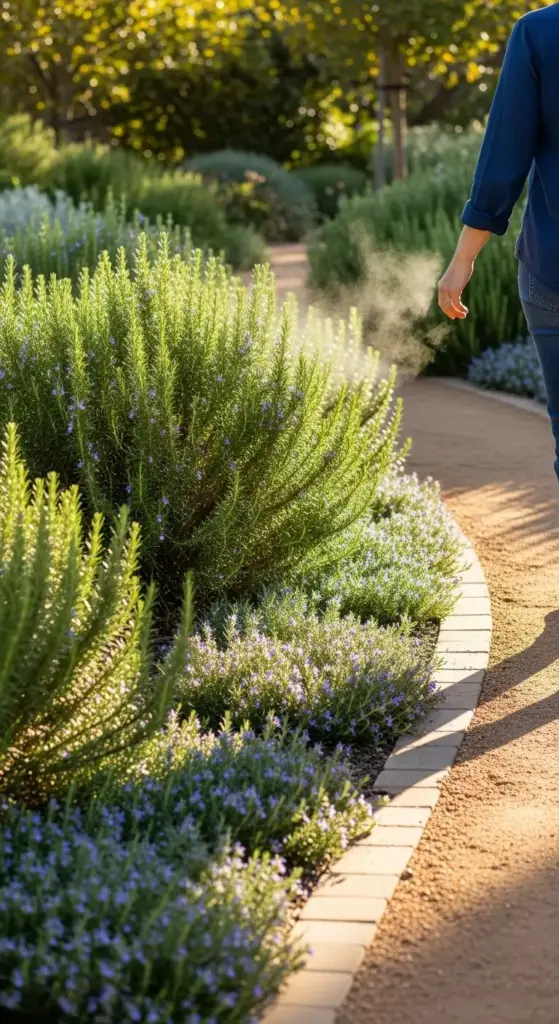4. Aromatic Pathway Borders: Guiding Guests Through Scented Journeys

The first time someone walked down my rosemary-lined pathway and stopped mid-step to say “Oh my gosh, what is that incredible smell?” – I knew I’d nailed it.
But getting to that point wasn’t easy. My first attempt at aromatic garden borders was a complete flop because I planted everything too far from the walkway.
Nobody was brushing against the plants, so nobody got that amazing fragrance release. Lesson learned the hard way.
Designing Walkways That Release Fragrance
The secret to scented pathway design is all about the “brush factor” – plants need to be close enough for people to accidentally touch them while walking.
I position my rosemary plants 6-8 inches from the pathway edge. Any closer and they’ll grow into the walking space, any farther and you miss the fragrance trigger.
Path width matters more than I initially realized. My main garden walkway is 4 feet wide, which gives people room to walk comfortably while still brushing against the border plants.
For narrower side paths, I go down to 3 feet wide max. Anything less feels cramped and people rush through instead of enjoying the experience.
Here’s my favorite design trick – I create slight curves in straight pathways. When people follow the curve, they naturally brush against more plants.
The pathway material affects the whole experience too. I use decomposed granite because it’s soft underfoot and doesn’t crunch like gravel.
Low-Growing Varieties That Actually Work
This took me forever to figure out because most rosemary varieties want to grow tall, not stay compact for pathway edging.
‘Prostratus’ rosemary became my go-to choice. It stays under 2 feet tall and spreads horizontally, creating this gorgeous cascading effect over pathway edges.
‘Huntington Carpet’ is another winner – it literally grows like a carpet and releases incredible fragrance when stepped on. Perfect for areas where the path might get some foot traffic.
My biggest variety mistake was using ‘Tuscan Blue’ thinking I could just keep it pruned short. It looked terrible and kept trying to grow upright no matter how much I cut it.
‘Lockwood de Forest’ works beautifully for slightly taller borders – stays around 18 inches and has this amazing trailing habit that softens hard pathway edges.
For really low borders, ‘Creeping Blue’ hugs the ground at just 6-8 inches tall but spreads 3-4 feet wide.
Creating Visual Rhythm and Flow
Alternating rosemary textures along pathways creates this incredible visual movement that draws people forward.
I alternate between upright varieties like ‘Arp’ and trailing ones like ‘Prostratus’ every 6 feet. It creates this wave-like rhythm that’s super pleasing to the eye.
Color variation is just as important as texture. I mix the deep green of ‘Tuscan Blue’ with the lighter, almost silvery foliage of ‘Majorca Pink’.
The flower colors add seasonal interest – blue flowers in spring, then the pink varieties bloom in summer, keeping the pathway interesting year-round.
I learned to plant in odd-numbered groups – clusters of 3 or 5 plants create more natural-looking drifts than even numbers.
Spacing consistency is crucial for good rhythm. I measure and mark every planting spot before I start – eyeballing it never works.
Lighting That Enhances Evening Strolls
Pathway lighting completely transforms the rosemary border experience after dark, but it took me three tries to get it right.
My first attempt used those cheap solar stake lights. They barely lit anything and looked tacky during the day.
Now I use low-voltage LED strip lights hidden behind the rosemary plants. They create this gorgeous uplighting effect that makes the foliage glow.
The game-changer was adding motion sensors. Lights gradually brighten as people approach, creating this magical experience that guests absolutely love.
I space the light fixtures every 8 feet along the pathway. Closer spacing is overkill and farther apart creates dark spots.
Warm white LEDs (3000K) work better than cool white – they complement the Mediterranean feel of rosemary gardens.
For special occasions, I add string lights woven through the taller rosemary plants. Creates this enchanted garden vibe that’s perfect for dinner parties.
Companion Plants That Enhance the Experience
Pure rosemary borders can feel monotonous, so I learned to add complementary aromatic plants strategically.
Lavender varieties are perfect companions – similar growing needs but different textures and bloom times. I use ‘Hidcote’ lavender every 10 feet as accent plants.
Low-growing thyme planted at the base of rosemary creates layers of fragrance. When people step on it accidentally, it releases this incredible herbal scent.
My favorite discovery was adding catmint between rosemary plants. The soft purple flowers create beautiful color contrast and bloom all season long.
Ornamental grasses like fountain grass add movement and texture without competing for nutrients. I plant them sparingly as focal points.
Avoid mint at all costs – I made that mistake once and spent two years pulling mint runners out of my carefully planned rosemary borders.
High-Traffic Maintenance Strategies
Pathway border maintenance is different from regular garden care because these plants get more wear and tear.
I do light pruning every 6 weeks during growing season, focusing on removing any growth that’s encroaching on the walkway.
Mulching is essential but tricky – too much mulch and the low-growing varieties get smothered. I use a thin layer of fine bark chips, maybe 1 inch deep.
The biggest maintenance challenge is keeping the edges crisp. I use a half-moon edging tool every month to redefine the border between plants and pathway.
Watering high-traffic rosemary requires more attention because foot traffic compacts the soil. I installed drip irrigation to ensure consistent moisture without overwatering.
Seasonal replacement is just part of the deal. I keep a few backup plants in pots to replace any that get damaged or don’t thrive in high-traffic areas.
Spring fertilizing with a balanced organic fertilizer helps the plants recover from winter and handle the stress of constant brushing and occasional trampling.
Want to create a stunning focal point that draws the eye and calms the soul? Click “next” to discover how contemplation circles using dramatic rosemary centerpieces can transform any garden space into a peaceful sanctuary that rivals the most beautiful monastery courtyards!









GIPHY App Key not set. Please check settings